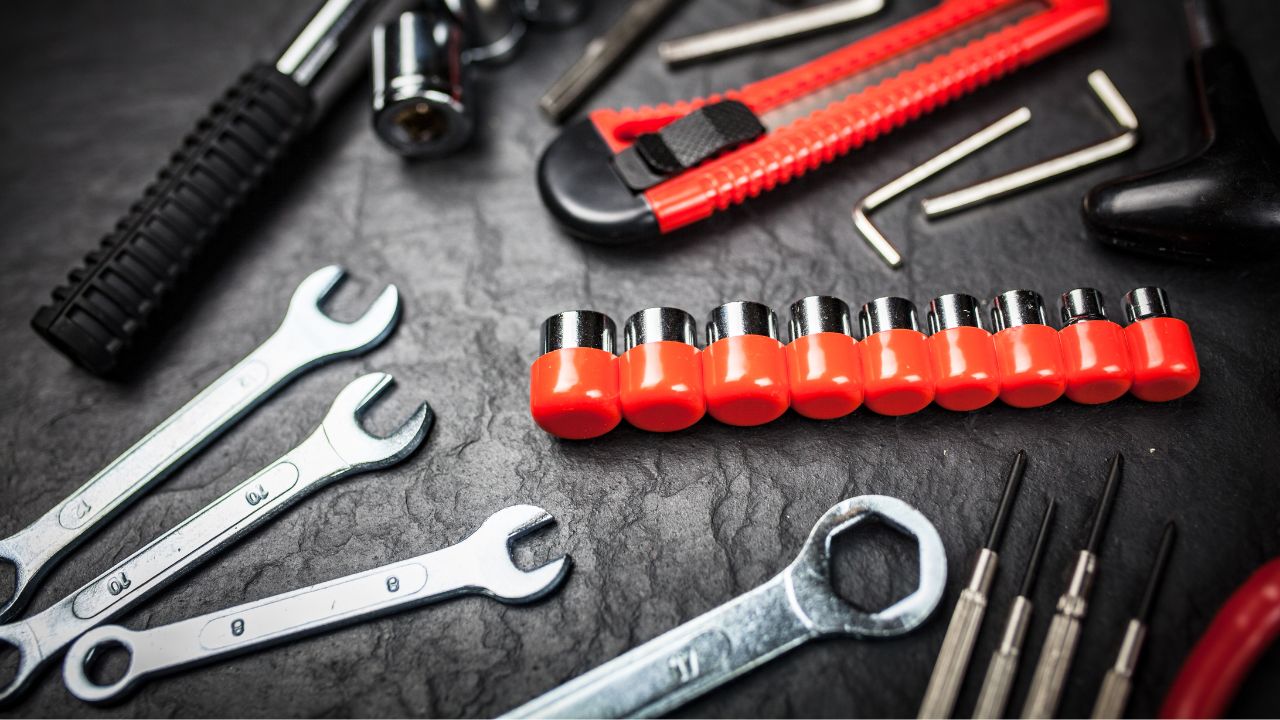Whenever you’re starting to build your tool set for working on cars, it can be overwhelming to look at all the options. There are all different kinds of tools and they don’t all have an automotive label on them for easy identification. If you’re a new technician just starting out in the business, there are a few tools that you need to get. There will be plenty more that you need and even more that you want, but if you start with these tools, you’ll have a good foundation to build from.
Personal Protective Equipment (PPE)
This is the stuff that you hear about in every safety and hazardous materials training. You only have one body, so it’s important to take care of it.
- Safety glasses are a must when working on cars to protect from flying debris, sparks, and compressed air. Safety goggles provide additional protection from chemicals.
- Steel toed or composite toed shoes protect you from accidental impacts like stubbing your foot on heavy equipment or dropping heavy metal parts on your toes.
- Ear protection in the form of ear muffs or disposable ear plugs will protect your ears from the abrasive loud noises that fill a shop.
- Work gloves protect your hands from exposure.
- Proper uniforms that fit well show you are ready to work while also not getting snared in equipment.
Flashlight
Nothing will make you look like a rookie as much as using your phone for a flashlight. There’s a wide range of types and costs when it comes to lighting. You don’t need every option in your toolbox, but one or two reliable lights are a must to see what you’re doing and properly inspect a vehicle. Rechargeable LED lights offer the most convenience.
- A flashlight you can keep in your pocket is perfect for inspecting common low light places under the hood, below the instrument panel, or beneath the vehicle.
- A headlamp is helpful when you need the light but also need both of your hands for the work.
Wrenches
No toolbox is complete without wrenches. Many premade sets will come with a range of sizes in Metric millimeters and Standard fractions. Metrics will by far be the most common wrenches you need for working on modern vehicles.
- Combination wrenches are a foundational tool for working on cars. Most sets will come in sizes 10-19mm and have offsets to give you the most versatility and access where you can’t fit any other tool.
- A 10-12” adjustable wrench will help you out with odd sizes that are larger than your other wrenches will fit on.
Ratchets and Sockets Set
Most premade sets will give you a wide variety to cover a lot of your needs. The most common size drive sets you’ll need are ¼”, ⅜” and ½”. Drive refers to the size of the square anvil that the socket fits onto. The size of the socket is what fastener it will fit. Like wrenches, metric sizes are what you’ll see the most. Here’s what to look for in a set or if you want to piece a set together yourself.
- One ratchet in ¼”, ⅜” and ½” will get you going, though you’ll probably get more.
- Metric chrome sockets, both in shallow and deep walled. You may need shallow for tight places or deep to get over studs.
Extensions and Adapters
Sometimes you need extra reach or a different fit with your ratchet and sockets. Extensions and adapters give you more flexibility in what sets you choose to use.
- In ¼” and ⅜” drive extensions, lengths of 1”, 3”, and 6” will cover most of what you’d need. A ⅜” extension of 12” is one I used a lot. Just starting out, a ½” extension that’s 3” will come in handy with stubborn cartridge style oil filters, or keep the wheels from getting scratched if you have to use a ratchet on lug nuts.
- Adapters, sometimes called reducers, allow your ratchets and sockets to adapt from one size drive to another. A set will come in ½” to ⅜”, ⅜” to ½”, ⅜” to ¼”, and ¼” to ⅜”.
Pliers
There are so many types and variations of pliers it can be difficult to know which ones to get. These few types are the backbones of any automotive pliers set.
- Adjustable groove pliers, commonly called channel locks, will grip nearly everything.
- Needle nose pliers give a precision grip when you need it in tight places.
- Diagonal cutting pliers can be used to cut, but they also have a rounded back that allows great leverage to pull things like nails from tires or cotter pins through castle nuts.
Screwdrivers
There are a couple options for your basic screwdriver needs. You can go with a full set of screwdrivers or, my favorite, a ratcheting screwdriver with bits you can swap out. Whatever you get, make sure you’ve got these bases covered.
- Flathead and Phillips head screwdrivers are the main ones so be sure to get each in a couple sizes. Especially a PH2.
- A stubby screwdriver in both types for tight access places.
- A pocket screwdriver is small with a magnet in the back, and fits in your shirt pocket. It may sound silly, but you will use this all the time. Watch out that you don’t lose it when the magnet inadvertently sticks to a door frame.
Specialty Sockets
Torx, E-Torx, and Allen sockets have different bit types and sizes installed in them. They are needed for a variety of components. These typically come in sets with ¼” and ⅜” drive. They’ll be used for engine covers, trim panels, interior components, tail light lenses, and many others. You may not see them every day, but they’re common enough to warrant being a must buy.
- Torx bits look like a 6 pointed star. Some techs even call them star bits. A variation of the Torx is tamper-proof Torx, which has a raised circle in the center of the star.
- E-Torx bits are the opposite of Torx. Instead of fitting on the interior of the star, they fit on the exterior. Engine components like valve covers and oil pans will use this the most.
- Allen bits look like a flat 6 sided hexagon and are common on engine covers.
Impact Wrench and Sockets
Impacts can be either air or battery powered and each technician has their own preference. When hand tools don’t cut it and you need more power and speed, you’ll need an impact.
- A ½” impact will be one of your most used tools. Taking wheels off a car is an everyday job, especially at entry-level.
- Impact sockets are black instead of chrome. They’re more heavy duty so they don’t break under the force of the impact wrench.
- Many shops will have them already, but if not, you’ll need a set of torque sticks when reinstalling lug nuts. Attach the torque stick that matches the specifications in service information to the impact wrench and socket. These look like extensions but are only designed to tighten – not remove – lug nuts. They are engineered to twist in just the right amount to deliver specified torque to tighten lug nuts.
Hammers
If you have a claw hammer in your toolbox, leave it at home. You’re fixing cars, not building houses. Two hammers will be a great starting point.
- A dead blow hammer is a specially constructed, rubberized hammer that has a head full of shot amplifies the impact. The rubberized head is non-marring so when wheels get stuck on rims due to rust, you can hammer them from the backside without damaging them.
- When you need more direct force, a ball peen hammer can be used to tap nuts and bolts that get stuck so they can be removed.
Removal Tools
These are ones you may not be familiar with, but are good to have in a beginner’s tool kit.
- A prybar set to persuade otherwise stuck components. Get ones with metal strikers on the back of the handle that you can use in conjunction with your ball peen hammer.
- An interior trim tool kit is a set of small, plastic, handheld prybars. These will allow you to remove interior plastic panels without breaking them.
- A miniature pick set is good for sticking connectors and removing O-rings.
Telescoping Tools
There’s two specific tools that would be easy to forget, but technicians will use these daily—So much so that they break a lot, so you don’t have to break the bank when you buy either one of these.
- An inspection mirror is valuable because it allows you to see components from angles you may not get your head to. I hope you didn’t forget your flashlight.
- A magnetic pick up tool is vital for when you drop one of your sockets down into an engine bay, and you can’t reach it with your hands.
Tool Storage
You don’t want to be an apprentice technician who shows up with a $6000 toolbox that has nothing in it. As one of my mentors told me, a toolbox doesn’t make you any money.
- A tool cart is perfect for starting out. Get one with a locking lid and drawers. It will allow you the mobility to move around the shop and not be confined to a single bay. You can upgrade later, and even when you do, your cart will still be useful to you.
The Key is Versatility
The strength of a tool set is versatility that allows you to adapt to a wide range of jobs and this list will get you started. These are all tools that will allow a beginning technician to take on most entry-level work. You’ll be able to complete routine maintenance on most vehicles, but also be ready to take on many next-level jobs to get you progressed out of working only on oil changes. What brands of tools to buy is a whole other topic. No two tool collections are going to look alike, so look for the tools that work for you. And of course don’t forget one of the unspoken rules of the shop: If you borrow it three times, you need to buy it.
Guest Blog Article By: Josh Simons, ASE Master Technician





